TRAVIS TAILWIND




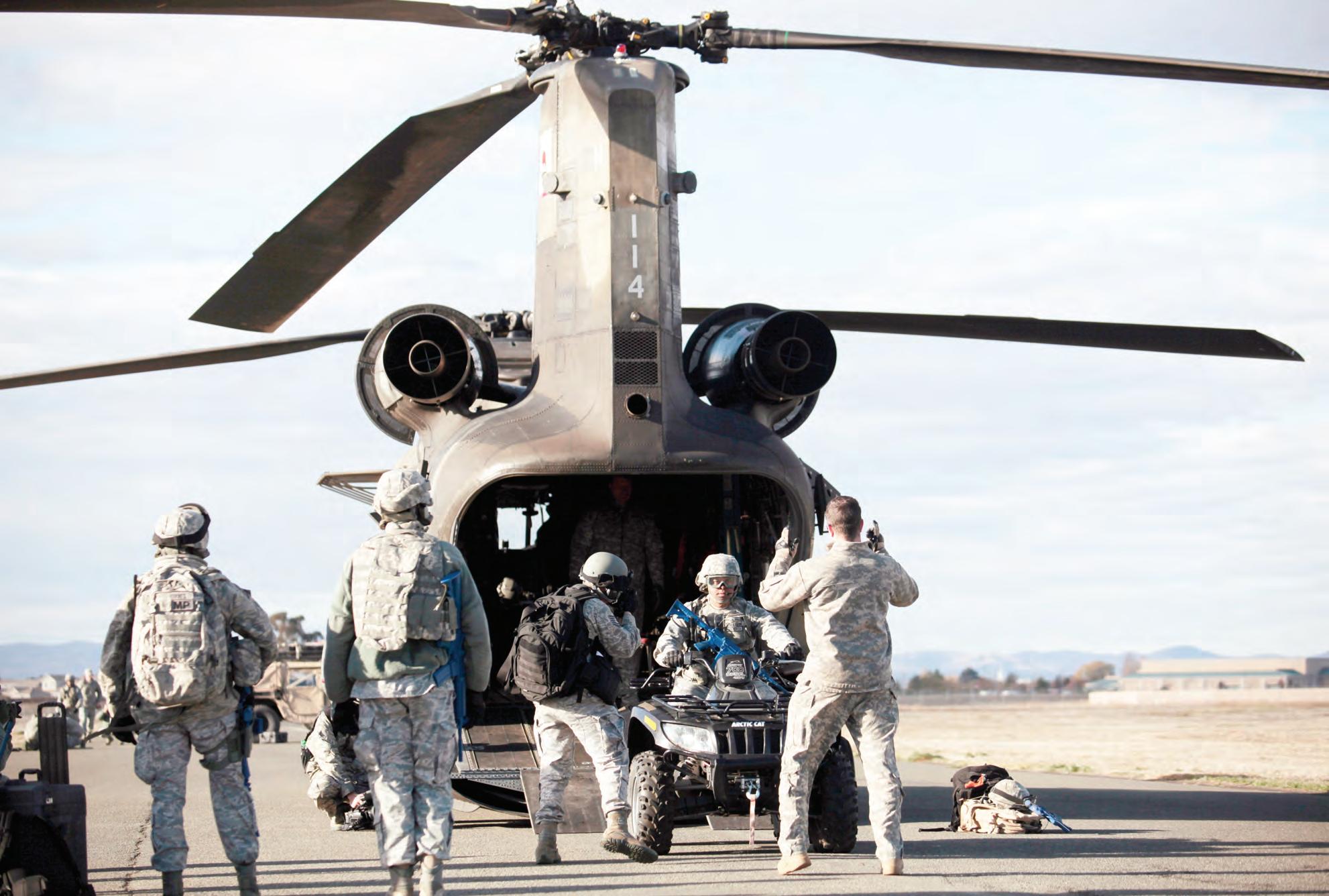



inked a letter of intent to cooperate in the program, Oct. 16.
The Netherlands also signed a separate agreement with General Atomics as part of a broader effort to boost the country’s defenses and drone tech.
“We think that this is a unique point in time and it reinforces the partnership we have with the U.S. And I think it also makes the world a lot safer if in the near future we can actually also operate CCA type of aircraft in the European theater,” Gijs Tuinman, Dutch State Secretary for Defense, told reporters after announcing the agreement at the Dutch embassy’s defense industry event.
The country has partnered with the U.S. on the F-16 and F-35, which makes a CCA investment a natural next step that help proliferate the tech across Europe, Tuinman said, noting the Netherlands needs roughly equal numbers manned, unmanned, and attritable systems for its defenses.
See Robot, Page 3

DAily r epubliC sTAff
FAIRFIELD — Petty
Officer 2nd Class Fernando Vera, a native of Fairfield and 2006 Armijo High alum, is working on his associate’s degree in math and science while serving in the U.S. Navy.
Assigned to the Waspclass amphibious assault ship USS Essex out of San Diego, Vera is attending Coastline Community College and expects to have his degree next year.
“I learned growing up to always stay true to myself, to be humble and to never forget what I am fighting for,” Vera said in an article from the Navy Office of Community Outreach and originally written by Rick Burke.
Vera joined the Navy 11 years ago, and serves as an aviation boatswain’s mate on the Essex.
“I joined the Navy to put myself in a better position for a career,” Vera said.
The Essex is 872 feet long and weighs 40,500 tons.
“Essex plays a crucial
role in projecting power and maintaining presence for naval forces. It serves as the cornerstone of amphibious operations, capable of carrying Marines, their equipment, and aircraft to execute a wide range of missions, from humanitarian assistance and disaster relief to full-scale amphibious assaults. This ship enables forces to rapidly deploy and sustain operations in littoral (near-shore) environments, providing a versatile platform for achieving strategic objectives across the globe,” the Navy Office of Community Outreach stated.
Essex carries a crew of 1,200 officers and enlisted personnel and can accommodate up to 1,800 Marines.
“My proudest accomplishment is getting to a leadership position that allows me to mentor junior sailors,” Vera said.
“Serving in the Navy has given me a lot of opportunities to better myself and to give my family a better future.”
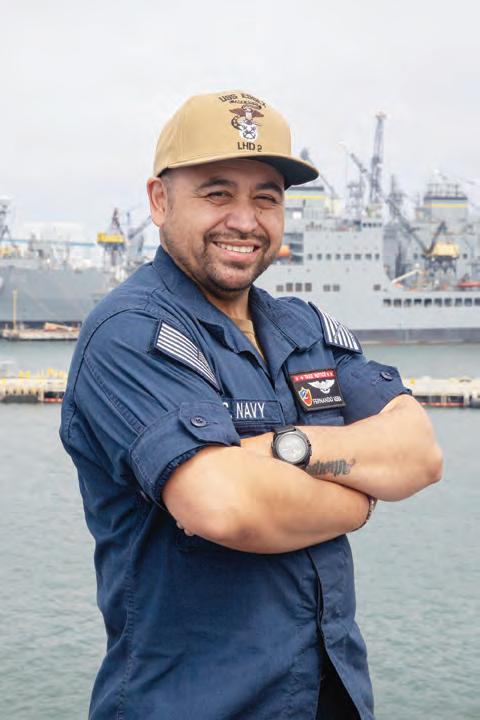
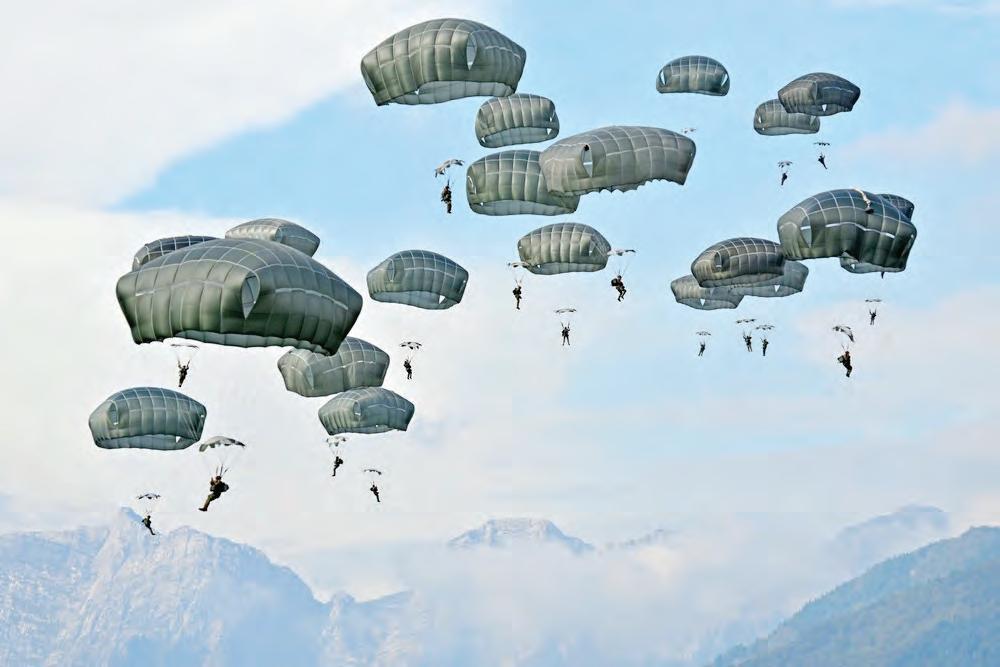
Tribune ConTenT AgenCy
AVIANO AIR BASE
Italy — The second week of October was unseasonably warm around Aviano Air Base, Italy, with several warm days of almost cloudless skies.
That made it just a bit easier for hundreds of Sky Soldiers to practice their craft: Jumping from an aircraft hundreds of feet above the ground.
It took less than a minute for each soldier from the 173rd Airborne Brigade to touch the ground after exiting a pair of C-130Js from the 37th Airlift Squadron onto the Juliet Drop Zone in a series of training jumps launched from the base.


Serving Travis Air Force Base and the surrounding community 1250 Texas St., Fairfield, Calif. 94533 707-425-4646 | Fax 707-425-5924
Publishers: Foy S. McNaughton and T. Burt McNaughton
Advertising Manager: T. Burt McNaughton Editor: Todd R. Hansen Layout : Aaron Rosenblatt
does not constitute an endorsement by the Department of Defense, the Department of the Air Force or the Daily Republic of the products or services advertised. Those off base who wish to receive home delivery of Travis Tailwind can call 707-427-6975. For information on paid advertising, call 707-425-4646. Send correspondence to: Travis Tailwind/Daily Republic, 1250 Texas St., Fairfield, CA 94533.


“A beautiful day for almost anything,” said Pfc. Zachary Pierce while helping Spc. Ian Hart secure his parachute and associated gear before a jump. That didn’t mean that soldiers were taking their tasks lightly. Far from it.
Though some might envy the brief – but somewhat stunning – views while gliding down on parachutes onto a green field at the foot of the Dolomites, there was a lot going on behind the scenes.
Soldiers making the jumps traveled from their home base in Vicenza, more than an hour away, and spent a good portion of their day waiting for their cues at the Personnel Alert Holding Area on base.
There, many watched a short presentation on the field – located about 20 minutes east of Aviano near the village of Vajont – and practiced lining up and exiting from




a metal structure that resembled an aircraft (with some imagination).
They eventually paired off and helped each other don one of hundreds of parachutes methodically packed by their colleagues based at Aviano. After a backup chute and other gear totaling roughly 100 pounds was added, they sat along rows of wooden benches specifically designed for the task.
Jumpmasters – sol-
diers who have passed an advanced training school and been on at least a dozen jumps themselves – then inspected each soldier’s gear from head to toe, ensuring that everything was just right.
“It’s a very thorough inspection,” said 2nd Lt. Dustin Buwal while finishing up his review of Hart’s gear.
Then it was a few more hours of waiting until the call was made to stand up

and cross the South Ramp onto the waiting aircraft. Two C-130s, part of the 86th Airlift Wing at Ramstein Air Base, had made the trip over the Alps, Oct. 14, and stayed for the four-day event. Only one of them was available to make jumps the last three days due to a mechanical issue. That left some soldiers unable to jump. Those were bused later to the drop zone to join their comrades and take part in training on the ground. Some watched as their fellow Sky Soldiers glided onto the landing zone. All of those jumping had done so at least a few times before, having graduated from jump school. Some were making their first jumps onto the zone, though. A few others had achieved the designation of master jumper – with at least 64 jumps to their credit. Given the brigade’s
See Aviano, Page 4

Janus Program can provide the Army with on-demand nuclear energy
sgt. WooDlyne escaRne
U.S. ARMY
WASHINGTON,
D.C. — The Army highlighted its commitment to innovation, readiness and partnership during the Association of the United States Army’s Annual Meeting and Exposition, Oct. 14.
Secretary of the Army the Honorable Dan Driscoll announced the launch of The Janus Program, a next-generation nuclear power program designed to provide resilient, secure and reliable energy, strengthening warfighter readiness and combat lethality.
The Army is serving as the executive agent on The Janus Program, fulfilling President Trump’s Executive Order to advance nuclear technologies for national security by 2028. This program will ensure nuclear energy is a decisive advantage for the U.S. Army.
“This is about warfighting power,” said Secretary Driscoll, “Project Janus ensures our warfighters can train, deploy, and fight with the certainty that power will never be the limiting factor in victory.”
Modern combat depends on reliable
From Page 1
“The Netherlands is like the jumping pad for the United States to get into Europe. So we have always [had a] strong or transatlantic relationship. That’s my message here too: to sign the deal, but also to express that we understand the message from the U.S... that the Netherlands and Europe should shift the burden a bit” by increasing defense spending, Tuinman said.
The agreement allows the Netherlands access to the CCA program as it develops, to share data, and to provide input for requirements for use in Europe.
The Netherlands also penned an agreement with General Atomics to develop new small unmanned aircraft systems for intelligence, surveillance, and reconnaissance that are affordable and can hold a variety of payloads.
Tuinman said the drone industry lacks systems that can “penetrate [anti-access/ area-denial] bubbles and have a diverse set of ISR and strike capabilities.” General Atomics will work with Netherlandsbased VDL Defentec to engineer and produce the new systems.
The move comes months after General Atomics and fellow CCA-maker Anduril began pitching tailorable versions of the platform – and co-production – to European countries at the Paris Air Show this summer.
The Dutch partnership aims to address immediate security threats as Russia’s war on Ukraine persists and drone activity increases across Europe. Drones recently disrupted communications during a Dutch military exercise in Poland.
“Putin is testing us in every possible way,” Tuinman said. “Hybrid attacks are already taking place across Europe... including my own country. And over the past weeks, various locations in Europe have been
energy sources to conduct global operations. The Janus Program will provide critical power to our installations and their communication networks, weapons systems, and command nodes. Janus is designed to prevent installation and mission vulnerability to grid instability, natural disasters, or adversarial attacks.
The program will field nuclear microreactors capable of operating independently of the civilian power grid, ensuring uninterrupted power for forces in any environment through collaboration with the Department of Energy (DOE). By leveraging its nuclear regulatory authorities in partnership with the DOE, the Army will move forward with microreactors that are safe, resilient, and adaptable.
“Drawing on my experiences leading Project Pele, I will be personally overseeing Project Janus to ensure we deliver the safest, most resilient, and most effective nuclear energy program possible,” said Jeff Waksman, Ph.D., Principal Deputy Assistant Secretary of the Army for Installations, See Janus, Page 4
plagued by large amounts of mysterious drones testing the strength of our response, resilience, and most of all our alliance.”
Teaming with General Atomics, and other U.S. defense companies, also creates an opportunity to bolster defense industries on both sides of the Atlantic Ocean, Birgitta Tazelaar, the Dutch ambassador to the U.S., said during opening remarks at the embassy’s annual defense industry event.
Spending more on defense “means that we’re going to build up a European defense industry, but it also means that we’re going to work very well together with our American partners in doing so. And this is crucial. Look at our adversaries and our competitors. They are doing the same, and it is extremely important to keep our strategic advantage by working together and integrating our industrial bases to the extent that we both benefit,” Tazelaar said.



Daily Republic staff DRNEWS@DAILYREPUBLIC.NET
FAIRFIELD — A
Vallejo native is serving aboard the Wasp-class amphibious assault ship USS Boxer as an aviation boatswain’s mate.
Chief Petty Officer Pepito Corpus, who graduated from St. Joseph High School in the Philippines in 2017, joined the Navy seven years ago.
“I learned early on to be humble and to have patience because that is the key to success,” Corpus said. “You are going to fail sometimes, and that’s OK. What matters is how you get back up.”
Resembling a small aircraft carrier, the Boxer “plays a crucial role in

projecting power and maintaining presence for naval forces. It serves as







equipment and aircraft to execute a wide range of missions, from humanitarian assistance and disaster relief to full-scale amphibious assaults,” the Navy Office of Community Outreach stated in an article originally written by Senior Chief Mass Communication Specialist John Osborne.
the cornerstone of amphibious operations, capable of carrying Marines, their
“This ship enables forces to rapidly deploy and sustain operations in littoral (near-shore) environments, providing a versatile platform for



Air Force loadmasters with the 352nd Special Operations Wing sit on the back of a MC-130J Commando II as it performs low-flying training maneuvers during exercise Adamant Serpent 26 in Norway, Oct. 14. Adamant
Tribune ConTenT AgenCy
STUTTGART,
Germany — U.S. special operators are working on quick-reaction drills this week in Norway pairing elite American troops and hundreds of allied forces with a focus on securing the increasingly strategic High North.
Exercise Adamant Serpent, which began Oct. 12 and lasts two weeks, brings together some 400 allied special operations troops, U.S. Special Operations Command Europe said in a statement ahead of the exercise’s start.
U.S. special operators “will provide critical capabilities that address complex security challenges in response to adversarial aggression,” SOCEUR commander Lt. Gen. Richard Angle said in the statement.
The drills are staged from Rygge Air Base, which has become a focal point for the Pentagon in the Arctic. The U.S. has an array of projects underway at the location, where $200 million is being invested to develop the site into a hub for American troops rotating into the area.
This year’s exercise is focused on rapidly deploying U.S. and allied units to arctic and subarctic environments to rehearse fighting as a unified force, the Stuttgart-based SOCEUR said.
The strategic value of the High North has increased over the years, as melting sea ice opens the possibility of new shipping lanes and greater
From Page 3
Energy and Environment.
“This effort will directly underpin readiness, lethality, and the warfighter ethos – providing warfighters with reliable power in any environment, at any time.”
The Army partnered with the Department of War’s Defense Innovation Unit to bring this microreactor technology to the force quickly and efficiently. The Army will further provide technical oversight and facilitate the uranium fuel cycle and nuclear supply chain.
“The Janus Program is a strategic leap forward in American energy dom-


access to undersea natural resources that the Kremlin has its eye on. Russia has sought to fortify its position in the region with numerous military bases now in operation.
“Adamant Serpent is a very strategic exercise and with current global security dynamics, this gives a realistic backdrop,” Norwegian Brig. Gen.
inance,” said Hon. Emil Michael, Acting Director of the Defense Innovation Unit. “By fusing the Army’s operational might with DIU’s innovation engine, we’re delivering resilient energy to the warfighter. Together, the Army and DIU are driving a domestic nuclear industry that will strengthen U.S. energy security.”
The Janus Program will give soldiers the necessary edge in contested battlespaces by ensuring reliable uninterrupted, independent energy is available at all times. It will fuel installation resilience, power mission assurance, and guarantee warfighter dominance –ensuring the Joint Force remain the most lethal and ready force in the world.
Thomas Harlem said in the statement.
Danish and Swedish troops also are taking part in the exercise, with Sweden hosting some of the training events.
Adamant Serpent kicked off on the heels of NATO’s inauguration Friday of the new Combined Air Operations Centre in Bodo, Norway.
It is focused on enhancing the alliance’s ability to perform operations across the Arctic.
In addition, the special operations drills in Norway and Sweden overlap with another major NATO training event this week.
On Monday, the alliance kicked off its annual nuclear readiness exercise Steadfast Noon, which involved airspace over the North Sea. That exercise is focused on refining NATO procedures for executing its nuclear mission.
“We need to do this because it helps us to make sure that our nuclear deterrent remains as credible and as safe and as secure and as effective as possible,” NATO Secretary-General Mark Rutte said in a statement last week. “It also sends a clear signal to any potential adversary that we will and can protect and defend all allies against all threats.”
Tribune ConTenT AgenCy
WASHINGTON , D.C. — Army Human Resources Command has introduced artificial intelligence into noncommissioned officer boards to help more quickly evaluate who has the qualifications to be considered for promotion.
The driving force behind the Army’s Comprehensive Board Reform and Analysis program is to make boards more efficient, smarter and ultimately more transparent, Col. Tom Malejko, chief talent analytics officer at Army Human Resources Command, said last week during the Association of the U.S. Army’s annual meeting in Washington.
“The first thing to understand is that we are not using it to replace humans,” he said. “We’re using it very broadly to augment their decision-making.”
The command created a “naive” AI system that does not look at names, branches or ranks, but instead can screen out people who haven’t reached a certain command level or attended a specific school.
“Can we screen out individuals that are not really competitive for the process upfront ... helping our board members to focus their valuable time and resources on those individuals that are then most competitive for that selection?” Malejko said.
Maj. Gen. Hope Rampy, commander of Human Resources Command, said this has specifically helped in the sergeant first class evaluation boards, when every
NCO of that rank is being evaluated. Some are not competitive for the promotion yet but must get a merit list score. Before acting on AI decisions, Malejko said a team of people reviews every step the AI model considered to ensure there is no bias.
“Our approach is to work our way through our noncommissioned officer boards first, learn from them and then pilot from those,” he said. “Based on what we’ve learned, go back to Congress and ask for additional authorities so we can actually execute them within our officer boards, since Congress ultimately controls those responsibilities.”
The Army has, however, used an AI-like algorithm for the past four years to determine which officers should be invited to a promotion board, Rampy said. Each year their post-evaluation has helped programmers refine the algorithm to be more effective. In the beginning, more than 30 officers were overlooked by the system and had to be manually included, Rampy said. Now that’s down to about three to five.
“Because you can retrain it, it got better every year,” she said. The command is now looking to make a similar program to search the Army’s personnel and pay system for specific skills for a specific mission or job. Because soldiers can add skills, such as languages or hobbies, to their talent profile, this could include skills outside the scope of their job in the Army.

Capt. Jennifer French/U.S. Army file Network communication systems noncommissioned officer Sgt. Elijah Thiess trains on a U.S. Army portable UHF satellite antenna and a AN/PRC-158 Multichannel Manpack Radio during the 173rd Airborne Brigade Communicators Academy at Caserma Del Din and Caserma Ederle, Italy, Oct. 14. Army Human Resources Command has introduced artificial intelligence into noncommissioned officer boards to help evaluate who has the qualifications to be considered for promotion.
From Page 2
deployment schedule, the availability of aircraft

843 feet long and weighs 40,720 tons.
So the brigade looks to conduct such training at Aviano almost monthly. They also jump at other locations around Europe or in places such as north Africa during training. A few dozen Italian paratroopers jumped along with them this time, while some of their comrades and Italian police helped secure the perimeter on the ground. Since this was only jump training, that mainly consisted of making sure that nearby traffic – and a few curious spectators – were safely far away from soldiers drifting from the sky.
“My proudest accomplishment is seeing my junior sailors succeed,” Corpus said. “To see them grow as sailors and people makes me so proud.” He added, “Serving in the Navy is all about my sailors and completing the mission. They are what keep me going and inspire me to wake up every day with the purpose of doing a great job.”
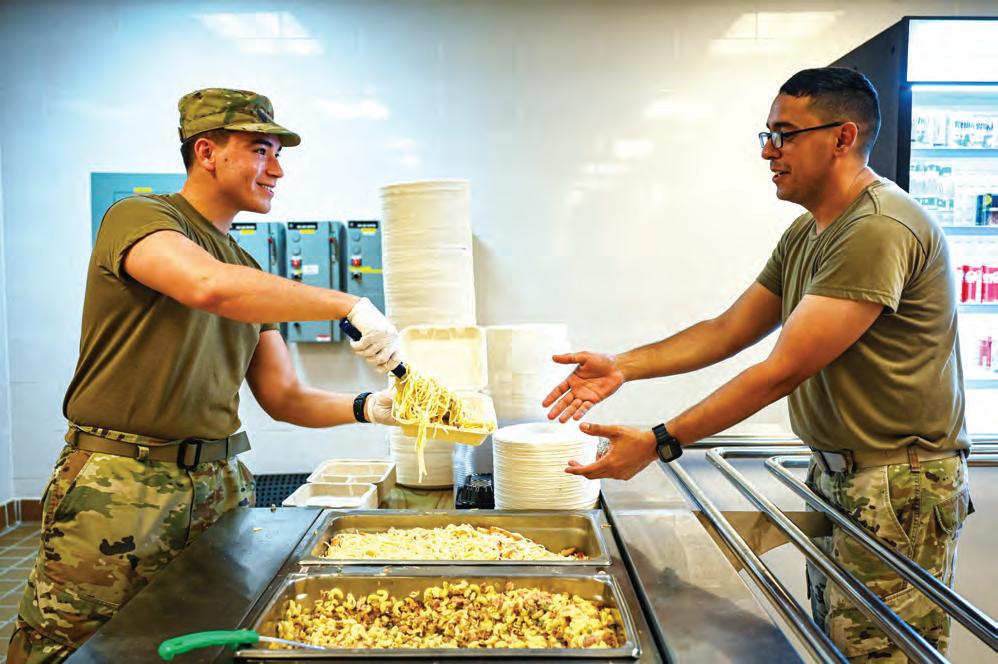
a rmy & a ir Force exchanGe Service
PuBLic a FFairS
TRAVIS AIR FORCE
BASE — Travis Exchange is honoring active-duty military members, retirees and veterans who have in-store shopping benefits with exclusive limited-edition giveaways throughout November during its first Salute to Service month.
month. POGs – cardboard currency – are a military tradition and now a collectors item. The original POGS go back nearly 25 years to support troops deployed to Southwest Asia in the early 2000s.
DAEGU
Republic of Korea — When Air Force members arrive in overseas locations to participate in exercises, they often rely
either MREs (meal, ready to eat) or contracted food vendors. However, airmen with the 11th Air Task Force and 11th Combat Air Base Squadron had a different experience while participating in exercise Ulchi Freedom Shield this August at Daegu Air Base in the Republic of Korea.
Airmen from the 11th CABS had the opportunity to move into the base’s dining facility, which stands unused most of the year, and serve hot meals four times a day: breakfast, lunch, dinner and a midnight meal for airmen working night shifts.
Staff Sgt. Justin Ruiz, 11th CABS dining facility manager, said his team strategically selected A-Rations over MREs for several key reasons, including the ability to fully implement the base operating support-integration concept and the fact that hot meals significantly contribute to troop morale.
“The way the Air Force is moving, we’re reutilizing old assets and getting them primed and ready to go,” Ruiz said. “Offering hot meals was a crucial factor in fostering a positive environment and supporting peak performance, as well as highlighting the development of a mature base.”
According to Ruiz,

running the DFAC required close coordination with the base’s host unit, the 8th Materiel Maintenance Squadron. As early as December 2024, 11th ATF members had assessed the base’s ability to offer a dining facility instead of hiring vendors to bring meals on-site. Next, they established relationships with local food suppliers so that everyone was stocked in time for the force’s arrival to participate in UFS25. A team of about 20 airmen from various Air Force specialty codes arrived earlier than everyone else to purchase any other necessary equipment, prepare the space and go through a full public health inspection like any other dining facility receives.
Because of this early
coordination, airmen were able to receive hot meals the day they arrived at Daegu. The 11th CABS services team supported a peak of more than 800 personnel, serving approximately 18,000 meals throughout the exercise.
This service was especially impressive since the DFAC team only had 15 members. The facility ran 24/7, and members usually worked 12-hour shifts, with one day off. To support the small team, airmen from other Air Force specialty codes – ranging from ammo to legal, combat communications to medical – volunteered to take shifts as mission ready airmen. They received just-in-time training such as how to handle
food, serve and even cook if they were interested.
“The MRA concept helped overcome manpower obstacles,” Ruiz said, adding that it aligns with the Air Force’s broader vision of agile capabilities and smaller, more versatile teams.
“The diverse skillsets from each AFSC strengthened our team’s ability to support the 11 CABS, while sustaining efficient operations. There’s not a lot of training required to operate here, and then you can help where it’s needed and get the job done.”
Senior Airman Alex Mejia is a cyber defense operator with the 11th CABS by trade but volunteered to support the DFAC throughout the
See Dining, Page 6
“This November, the Exchange is introducing Salute to Service month, paying tribute to our nation’s heroes on more than just Veterans Day,” Travis Exchange General Manager Cathie Byrns said. “One day is not enough to honor those who raise their right hands and take the oath to protect and defend our great nation. Our heroes serve every day, and the Exchange is honoring them all month long.”
In-store Salute to Service giveaway dates include: Nov. 1 and Nov. 29: POGs are back! Collectible penny POGs, with service-specific artwork, were specially designed for Salute to Service
Nov. 11: Veterans Day collectible challenge coin, an Exchange tradition since 2020, features an eagle on one side and the emblems of all six military branches on the other.
Nov. 15: Vet for Life decals let heroes display their commitment to our nation on their vehicle, laptops, water bottles or anywhere. Nov. 22: Vet for Life patch honors military tradition and reinforces unity and morale. At the Exchange, all who served are veterans for life. Giveaways are in-store only for activeduty service members, retirees and service-connected disabled veterans with in-store shopping benefits. Quantities are limited. Shoppers can visit ShopMyExchange. com/SaluteToService for more information or contact their local PX/BX.

a rmy & a ir Force exchanGe Service PuBLic a FFairS
TRAVIS AIR FORCE
BASE — Military families can visit the Travis Exchange for a free instore Hasbro game time event featuring classic games such as Monopoly, Battleship, Jenga and more from noon to 3 p.m. Nov. 1.
“Team Exchange has been honored to welcome military families this fall for family-friendly inter-
active events,” said Travis Air Force Base Exchange General Manager Cathie Byrns. “Closing out the free event series with family game time reinforces the Exchange’s commitment to serving those who serve, including their loved ones.” Pre-registration for events is not required. For more information, shoppers can contact the Travis Exchange or visit the Travis Exchange’s social media pages.

















a rmy & a ir Force
exchanGe Service
PuBLic a FFairS
TRAVIS AIR FORCE
than Feb. 13.
DAEGU AIR
Republic of Korea — When Senior Airman Halle Kenty-Fleming, a personnel specialist, volunteered to join the newly developed 11th Air Task Force in 2024, she never dreamed it would mean returning home.
Stationed at Holloman Air Force Base in New Mexico, Kenty-Fleming is originally from Saipan, Northern Mariana Islands. She hadn’t seen her family there since she left for basic military training in August 2023.
“In my head, when I volunteered, I was thinking, ‘We’re going to the Pacific, so it’s like home,’” she recalled. “Later on, when they asked me where I was from, I said, ‘Oh, I’m from this tiny island called Saipan. Not a lot of people know about it.’ And that was where we were going! I was so shocked… My first deployment was back home.”
A unique opportunity
Based in Davis-Monthan Air Force Base, Tucson, Arizona, the 11 ATF is one of six task forces activated across the Air Force in 2024. Composed of about 350 airmen from a handful of units, including Holloman AFB, the task force spent the last nine completing training requirements in an expedited Air Force Force Generation cycle, which is built to enable airmen to train and exercise together before being operationally employed together as part of a team.
This is a change from how the Air Force traditionally has filled deployment billets, when airmen were pulled from bases across the force and often didn’t meet until they arrived downrange.
The task force made history in July when it began its six-month deployment, the first in the Air Force. The first stop was to support exercise Resolute Force Pacific in Saipan. Kenty-Fleming ended up working only a
From Page 5
entire exercise. With justin-time training, he was able to move from basic cleaning tasks to serving and cooking food, even coming up with some of his own creations such as guacamole and ceviche.
Mejia said working in the DFAC gave him a deeper appreciation for the hard work the dining team puts in every day and pushed him out of his comfort zone to become more adept at helping with other mission needs besides his primary training.
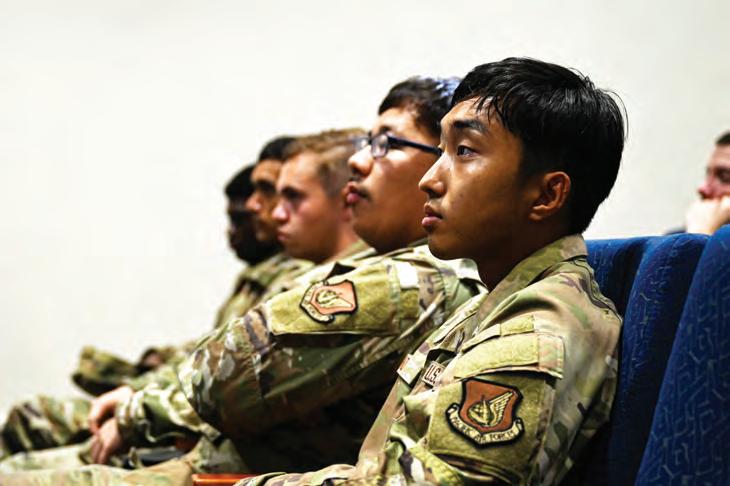
An airman assigned to the 51st Fighter Wing listens to an in-processing brief given by the 11th Combat Air Base Squadron while participating in exercise Ulchi Freedom Shield 25 at Daegu Air Base, Republic of Korea, Aug. 19. UFS 25 serves as a regular exercise between the ROK and the U.S., ensuring constant preparedness for military forces.
few minutes from her family’s home and was able to see them every day.
Seeing her family again was especially meaningful because they had tried to come to Kenty-Fleming’s BMT graduation but had been delayed in Japan and couldn’t make it. She remembered her husband calling her the night before to break the bad news.
“They were crying, and I was crying,” she said. “So, this was the first time I’d seen them in two years.”
Growing up in Saipan, Kenty-Fleming didn’t leave the Commonwealth of Northern Mariana Islands until her husband’s graduation from BMT. She had been interested in enlisting before that, but her parents had encouraged her to pursue higher education first. Seeing her husband’s graduation refueled her desire to serve her country.
“It made me realize that the world is so big,” she said. “I thought, ‘This is something I feel like I should do.’ I wanted to push myself, see the world and become a better version of myself.”
Kenty-Fleming said she experienced culture shock when she arrived at basic training, and it was still difficult to adjust at her first duty station. However, with the help and support of her leader-
“Being an MRA means being able to get the job done,” he said. “It was a lot of work, but I like to help people, and the people were awesome. It was really satisfying to hear, ‘Who made the chicken today?’ and be able to say, ‘That was me!’” Because of his own team’s hard work and the support of other MRAs, Ruiz said they were able to find creative ways to offer more choices and have fun, such as baking cookies and banana bread, ordering fresh fruit and providing several different drink options. The team was even able to host an Air Force birthday celebration dinner, albeit a little early, incorporat-
ship, she not only learned her duty responsibilities as a personnelist but has also thrived in her position, earning a senior airman below the zone promotion and airman of the quarter for the 49th Force Support Squadron.
“I love my job as a personnelist,” she said. “We get to meet and help so many people. Also, we have really good leadership at Holloman. They’ve been really pushing me to get out of my shell, encouraging me to do more. I feel like I have really grown within the Air Force and have made a difference here. Joining the military helped me see there’s so much more that I could do.”
Growing while deployed
Kenty-Fleming has continued pushing herself while deployed. Wanting to become better at public speaking, she began offering in-processing briefs and has briefed more than 300 members since her team left home station. She’s also been able to help outside her own duty title as a mission ready airman, assisting in the dining facility or in other ways.
“My leadership team within the 11 ATF is very supportive and handson,” she said. “I couldn’t speak publicly before this deployment; I would get so nervous, I’d start shaking. For me to be able to that
ing a celebration of all the members who had birthdays throughout the 11th ATF’s deployment. This dinner included steak, lobster and a giant cake.
“We’ve been blessed with a really good team,” Ruiz said. “It comes from the top all the way to the bottom, our senior leaders all the way down to our managers and shift leaders, keeping that positive attitude. When the team sees that they’re being recognized for their hard work, they’re able to keep pushing. Our team’s dedication and efficiency allowed us to provide outstanding support to the troops on the ground, during exercise Ulchi
and after.”
BASE — This season, the Travis BX is inviting shoppers to spread cheer by sharing their most memorable holiday moments for a chance to win big in the Mars Holiday Storybook Essay Contest. From Oct. 31 through Dec. 25, authorized Exchange shoppers can submit an original essay in English – 500 words or fewer – about a favorite childhood or recent holiday memory. Entries must be emailed to sweepstakes@aafes.com with “Favorite Holiday Story” on the subject line.
Three winners will each receive a $1,000 Exchange gift card, with winners to be announced no later
“Every holiday season brings stories that connect us,” Travis Exchange General Manager Cathie Byrns said. “Through this contest, the Travis BX is honored to celebrate those moments of joy and give the community a chance to win great prizes for sharing their stories.”
No purchase is necessary to enter. Department of War and Coast Guard civilians and honorably discharged veterans who have confirmed their eligibility to shop online may also enter. Veterans can visit https://aafes.media/ paveterans to learn more about their shopping benefit. DoD civilians can visit https://aafes.media/ cacbenefitspa. For full sweepstakes rules, visit Shop MyExchange.com/ sweepstakes.

point where I could confidently brief, my leadership would have me practice my brief and then give feedback. Then when it came to the actual briefings, I wasn’t even bothered by all these people looking at me. I already knew what to say. I was prepared.”
Overall, Kenty-Fleming said she’s glad she joined the Air Force and volunteered with the 11 ATF.
“It’s been really great with the ATF,” she said. “I feel like I’m really learning a lot, especially within my job. I’m really glad to have joined the Air Force because it opened up so many opportunities for me.”
Travis Exchange to give away free LEGO flag sets Nov. 1
a rmy & a ir Force exchanGe Service PuBLic a FFairS TRAVIS AIR FORCE BASE — The Travis Exchange is giving military kids a chance to build memories brick by brick during a free makeand-take LEGO event at the Travis BX. Military kids can let their creativity click by building – and taking home – an exclusive American flag set, marking the first makeand-take event sponsored by LEGO. The sets are free while supplies last.
“The Travis Exchange is honored to unite our nation’s youngest heroes ahead of Veterans Day to build with LEGO,” said Travis AFB Exchange General Manager Cathie Byrns. “Events like this bring the Travis community together to celebrate service.” Preregistration is not required. For more information, shoppers can contact the Travis Exchange, visit the Travis Exchange’s social media pages or go to the community Hub at ShopMyExchange. com/community.























Tribune ConTenT AgenCy
BRISBANE, Austra-
lia
— The United States and defense contractor Lockheed Martin have advanced a plan to build guided missiles in Australia as the allies work to expand their weapons stockpiles and deter China’s rapidly growing military.
The plan was outlined Oct. 13 in a joint statement and in a news release from Australian Defence Industry Minister Pat Conroy. It includes establishing a bilateral office in Huntsville, Ala., to help produce Precision Strike Missiles.

“There’s a global backlog of production of missiles as people ramp up production in response to the strategic circumstances,” Conroy told a Sky News reporter in Washington, according to a transcript provided by his office. “So, this is about making Australia safer by equipping the Australian army with long-range strike, but also contributing to allies and partners around the world.”



lian navy base near Perth, to support rotations of U.S. and British nuclearpowered submarines as early as 2027.
The missile initiative involves a $13.6 billion Australian investment in a guided weapons and explosive ordnance enterprise that will employ thousands of workers, Conroy said in his news release. The site will build Guided Multiple Launch Rocket System, or GMLRS, munitions and precision strike missiles.
“Australia is on track for the production of GMLRS munitions before the end of 2025, with a view to manufacturing more advanced weapons in the future,” he said.
Washington, D.C.
The announcement comes just days before the expected first face-to-face meeting between President Donald Trump and Australian Prime Minister Anthony Albanese in
New missiles will allow the Australian army to strike targets more than 600 miles away, Conroy said in his release. The goal is to build a factory capable of producing up to 4,000 missiles annually to support the U.S. and other partners.
It also comes at a key moment for the AUKUS security partnership, as the Pentagon reviews plans to sell Australia nuclear-powered submarines. Infrastructure work began last month at HMAS Striling, an Austra-
Guided missiles featured prominently at Talisman Sabre, a threeweek, biennial military exercise held in July and August. More than 40,000 troops from the U.S., Australia and 17 other nations trained across Australia and Papua New Guinea.
The training included the first live fire in Australia of the U.S. Army’s Typhon mid-range missile system and the debut of Australia’s High Mobility Artillery Rocket System, or HIMARS, which fired a Precision Strike Missile with a range of more than 310 miles.
“Prior to the introduction of HIMARS and GMLRS and PrSM, the longest-range strike weapon of the Australian army was [25 miles],” Conroy told reporters Monday in Washington, according to another transcript provided by his office.
Naval officers from the U.S., Australia and Japan also signed a logistics agreement aboard the amphibious assault ship USS America during a July 11 port call in Brisbane. The pact allows for faster missile reloads and more flexible refueling, according to a U.S. Navy news release.


































